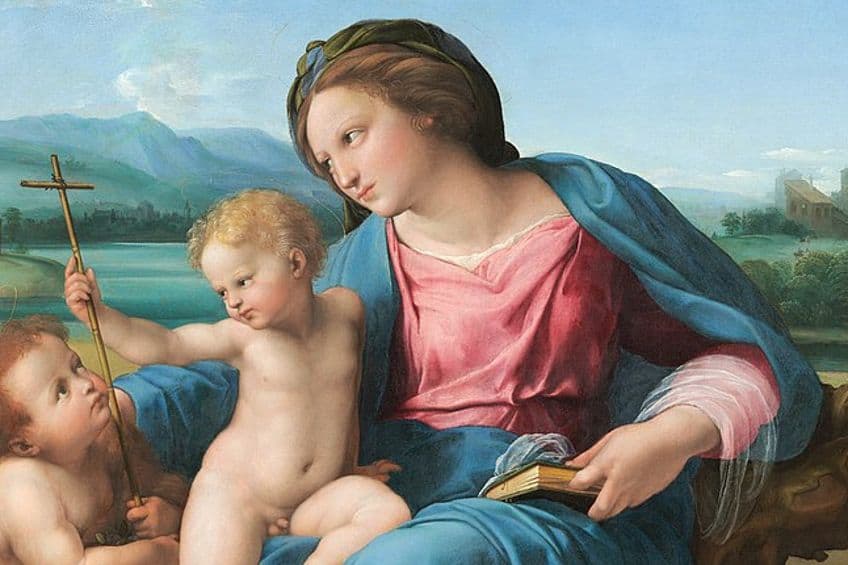High Renaissance Art – Explore the Return to Classical Ideals
The High Renaissance time period refers to a 30-year period typified by pioneering, famous artworks created in Italy amid what was regarded as a flourishing societal peak. A revival of classical art combined with an in-depth inquiry into the humanities inspired High Renaissance artists of unrivaled mastery, whose artworks were motivated by an intimate understanding of anatomy, science, and architecture. They are still regarded as some of the most awe-inspiring artworks of perfection in the historical art canon to this day. Read below to learn more about High Renaissance architecture and art, as well as learn about the High Renaissance characteristics.
Exploring High Renaissance Art
A cultural trend toward Humanism occurred during the High Italian Renaissance period, prompting High Renaissance artists to return to Classical Greco-Roman notions of universal man and his position in the universe. This was a shift from the exalted religious iconography of the medieval age, resulting in new portrayals of heavenly subjects with more resonating and genuine emotionality and expressiveness. A variety of approaches taken by Early Renaissance painters were used and improved on by High Renaissance artists.
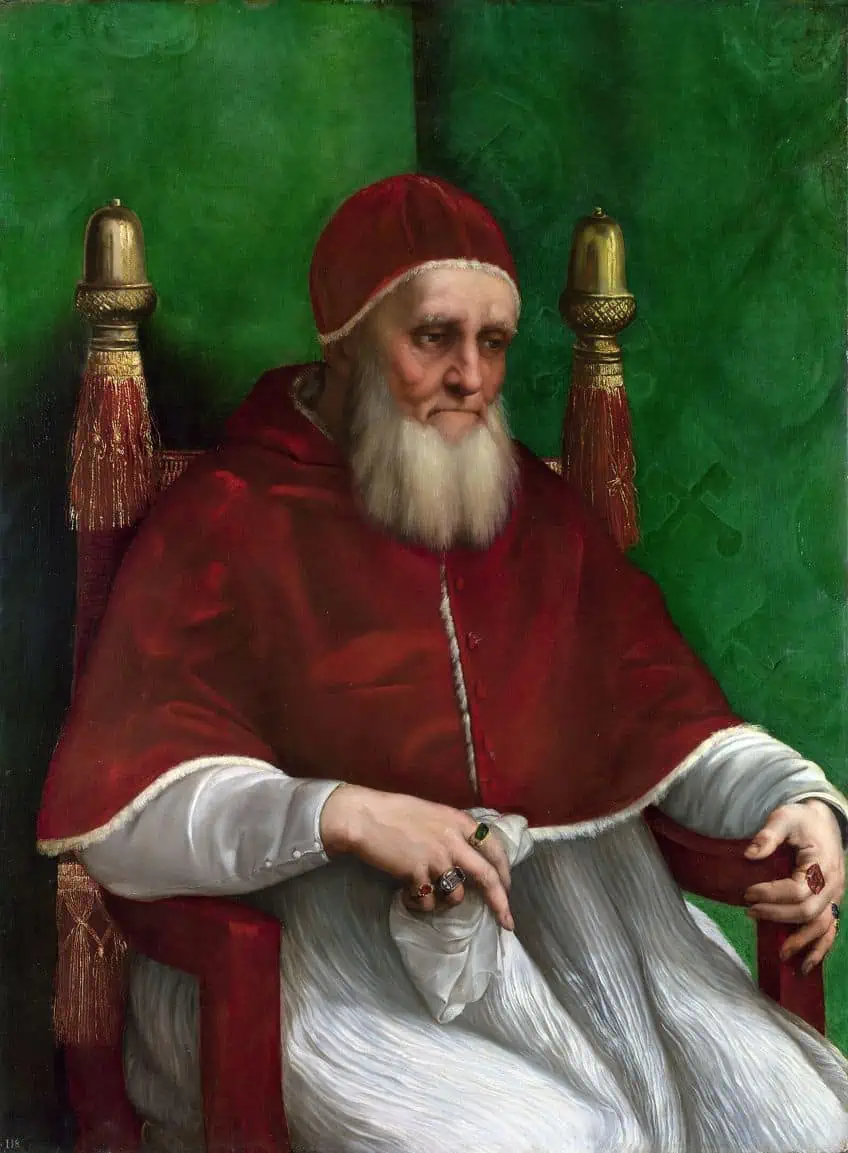
This includes the use of linear perspective to achieve incredible depth, as well as exceedingly realistic and scientifically precise portrayals of human anatomy. The era will be remembered for reintroducing notions of beauty into art. Whether painting sacred figures or normal inhabitants, the High Renaissance artists’ primary goals in High Renaissance architecture and art were to produce pieces of aesthetic, balanced, and compositional perfection.
The History of the High Renaissance
The shading, linear perspective, and naturalistic figurative treatment pioneered by Early Renaissance artists such as Masaccio and Mantegna impacted High Renaissance artists. They mastered such skills, however, in order to transmit a new aesthetic standard that emphasized beauty. The human form was viewed as representing the divine, and new methods like oil painting were used to express human movement and psychological depth through gradations of color and tone.
Using traditional Greco-Roman proportionate precision in architecture and anatomical accuracy in the body, artists such as Michelangelo, Leonardo, and Raphael produced strong compositions in which the pieces of their subjects were depicted as cohesive and harmonious with the whole.
The Impact of Da Vinci
The High Renaissance time period started with Leonardo da Vinci’s works of art such as The Virgin of the Rocks (1485), and The Last Supper (1490), which demonstrated dramatic focus, psychological complexity, symbolism, perspective, and scientifically correct detail. Both paintings, though, were completed in Milan, and it wasn’t until 1500, when Leonardo returned to Florence, a bustling hub of art and culture, that his work started to have an influence on the city. Da Vinci’s scientific grasp and awareness of natural events, as well as his sense of mathematical proportion, had a significant impact. Vitruvian Man (1490), his iconic ink artwork, demonstrated ideal human proportions matching with ideal building proportions advocated by Vitruvius, the Roman architect, in his De Architectura (30-15 BCE).
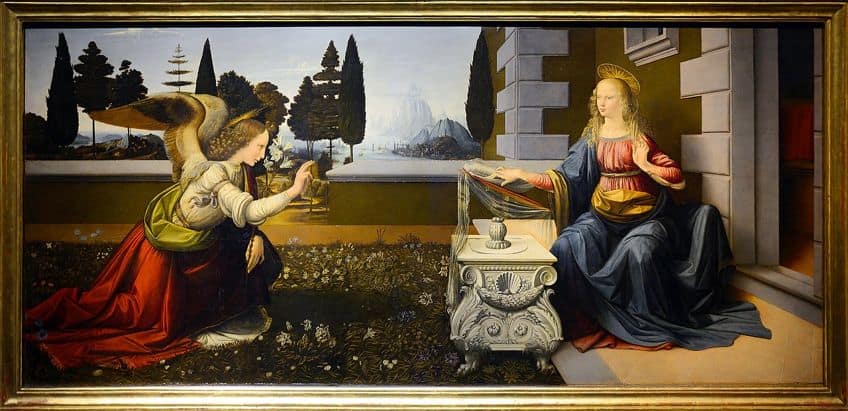
His text fills the work of art, illustrating his deep scientific research into anatomy, such as “the length of the arms of a man outspread is equal to his height”. Leonardo da Vinci was not just a famous artist, but also a polymath known as the founder of ichnology, architecture, and paleontology, among other things. He was a well-known cartographer, inventor, and engineer, and his observations, which he documented in notebooks, made their way into different collections, including the Codex Leicester (1510) and Codex Arundel (1518). These journals have become as valuable to certain individuals as his artworks.
The Age of Rivalries and Masters
The High Renaissance was shaped by a few recognized masters and the intense rivalries that arose amongst them as they competed for not just aristocratic patronage, but also top brilliance in their work. At the same time that people came to Florence to see Da Vinci’s drawing of The Virgin and St. Anne (c. 1500), Michelangelo established himself as a rising star with his work the Pietà (1498). Michelangelo considered sculpture to be the highest form of art and molded the human figure even in his paintings.
With the production of the legendary statue David (1504), he cemented his name as a sculptor whose works typified the High Renaissance.
David was granted a prominent position in Florence, preserving the city-state’s culture of safeguarding civil freedoms. Starting in 1504, when their competing murals were commissioned for opposite walls in the Hall of Five Hundred, Da Vinci and Michelangelo developed a rivalry. Michelangelo was highly competitive and wanted to outdo De Vinci.
It developed into a contest of creativity and ingenuity rather than talent, which they both had plenty of. The elder artist, Leonardo da Vinci, was already well-known not just as a talented artist but also as a really innovative thinker. Unfortunately, neither of the competing frescos was finished since both men were drawn to other contracts. Nonetheless, the paintings proceeded to impact other painters, most notably Raphael, who went on to imitate the masterpieces in order to advance their own artistic methods.
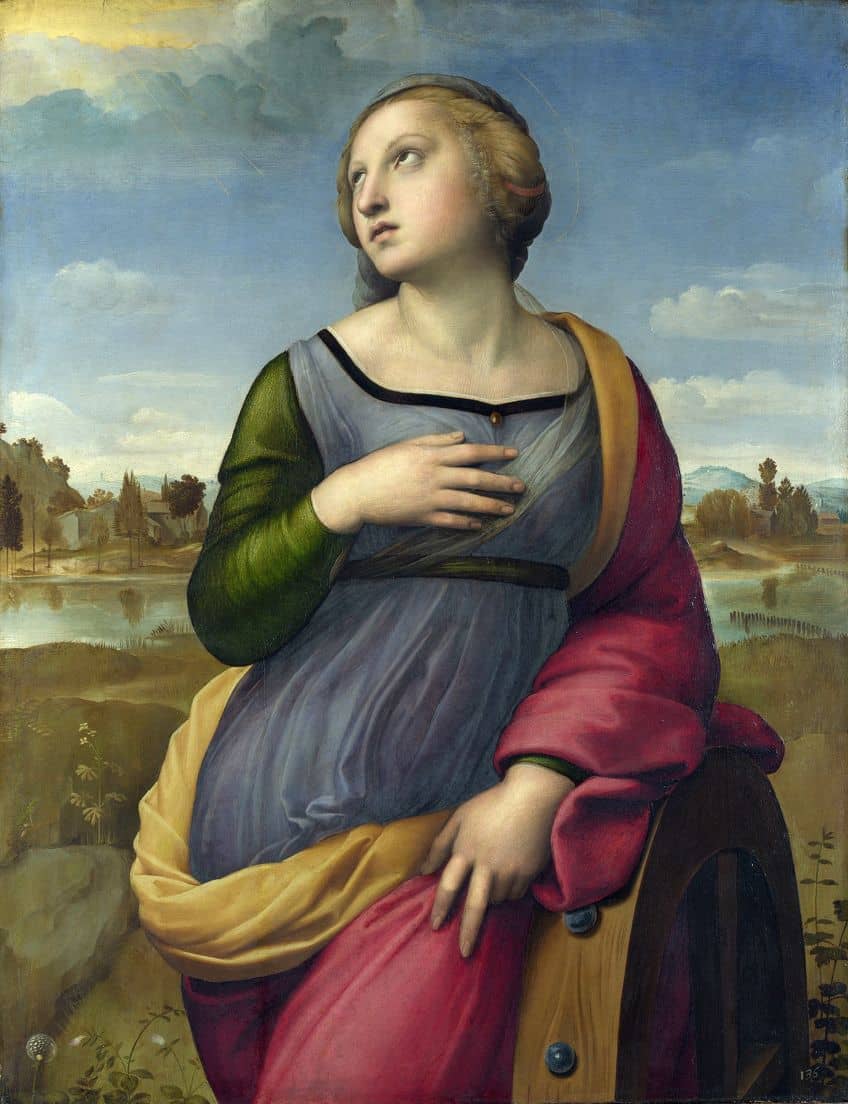
Pope Julius II
Due to the support of Pope Julius II, who ruled from 1503 to 1513, Rome became the creative hub of the High Renaissance time period. Julius II was a well-known art collector, amassing notable classical paintings that served as the foundation for the Vatican’s art institutions. He was a powerful personality who transformed the Papacy into a dominant military and economic force throughout most of Italy. His ambition was to make Rome, rather than Florence, the cultural hub of Europe.
To do this, he tracked the best painters of the day, convincing Raphael to go to Rome and create the paintings inside the Vatican’s papal palaces.
After ordering Michelangelo to design the papal tomb, Francis persuaded him to embellish the Sistine Chapel ceiling (1512). The Pope’s desire to restore St. Peter’s Basilica and restructure the Vatican led him to enlist the services of Michelangelo, Bramante, and Raphael as architects of his extensive ideas. Following Julius II’s death, Pope Leo X continued papal sponsorship of the arts.
High Renaissance Concepts and Trends
Humanist ideas were actively popularized throughout the Early Renaissance period. While the art of the preceding Gothic era stressed the idolization of the secular and sacred, painters in 14th-century Florence were more preoccupied with man’s role in the world. High Renaissance artists advanced this investigation by delving into the notion of a “universal man”, or a brilliant, divinely inspired human who could excel in all realms of science and art. The phrase “Renaissance man” continues to be utilized today to refer to a multi-talented individual who excels in a variety of academic and cultural activities.
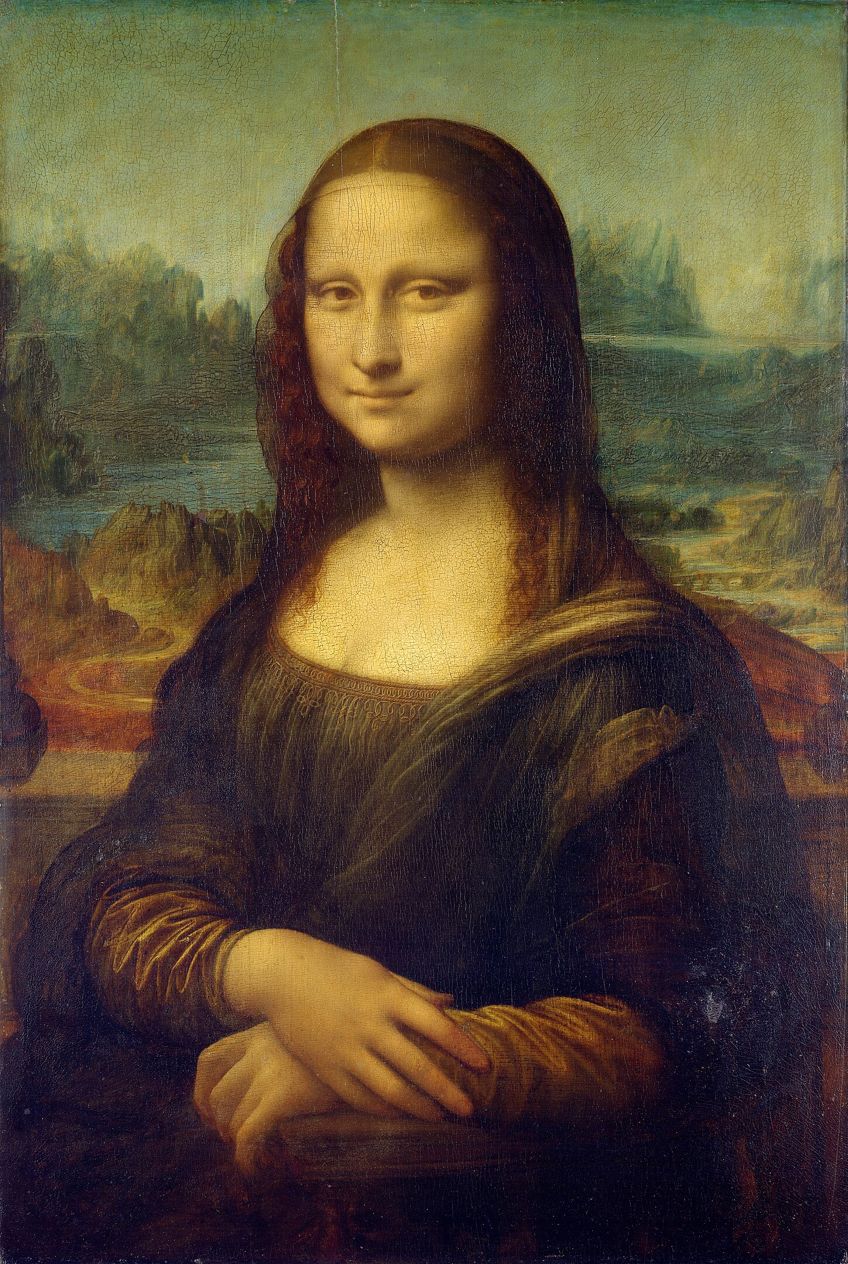
Vasari stated that Leonardo da Vinci was a prime example of this ideal and that in the ordinary course of things, many people are born with outstanding talents; but on occasion, in a manner that surpasses nature, a single person is brilliantly gifted by the Heavens with elegance, grace, and abilities in such quantity that he leaves others far behind, all his actions seem energized and all that he does clearly comes from God instead of from human skill. Everyone agreed that this was evident in Da Vinci, an artist of exceptional physical beauty who exhibited incredible elegance in all he did and who honed his mind to such an extent that he solved any issues he examined with ease.
This high standard not only influenced the time but also later concepts on creative aptitude, elevating the artist to the status of divinely inspired genius instead of just a skilled artisan.
Painting Innovations
While High Renaissance art followed the history of fresco painting in association with religious topics, the artistic style of masters such as Da Vinci, Raphael, and Michelangelo was influenced by media developments. To paint the Sistine Chapel, for instance, Michelangelo not only devised a scaffolding system for accessing the area, but also created a new fresco formula and method of application to combat mold, in addition to a wash technique and the utilization of an assortment of brushes to initially apply color before proceeding to add shading, fine detail, and line. Da Vinci experimented with dry fresco and a blend of tempera and oil to obtain an oil painting impression for his Last Supper (1490s).
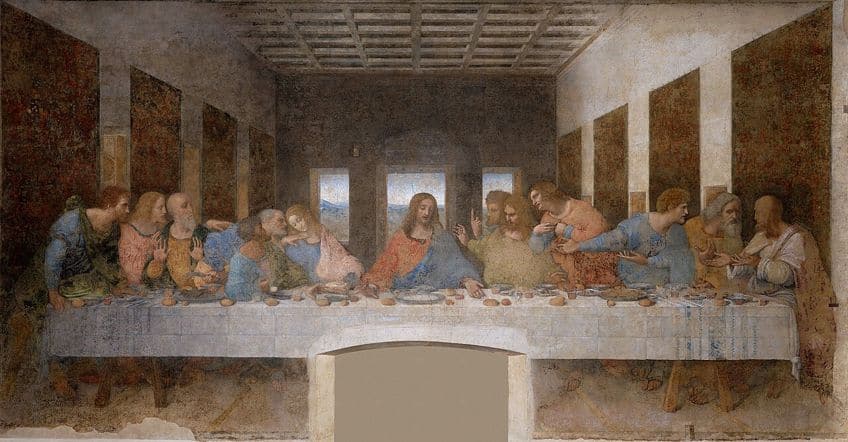
Trompe l’oeil, a method used to create the appearance of a pictorial space that fits into its surrounding architectural context, was used by Da Vinci, Raphael, and Michelangelo in their frescoes. At the same time, several High Renaissance artworks were being created in oil for the first time, often on wood panels but occasionally on canvas. The ensuing works were more life-like because oils allowed for more nuanced tone and color gradients. As a consequence, a powerful corpus of portraits of regular people arose. The most renowned instance is the Mona Lisa (1503).
Other High Renaissance artists who worked in oil were Andrea del Sarto and Fra Bartolomeo. Da Vinci’s oil painting experience prompted him to invent a new technique called Sfumato, which means “vanished gently like smoke”.
It entailed applying transparent glazes with a brush to produce smooth transitions between shadows and light tones. This resulted in a look, “without borders or lines, in the manner of smoke”, as Da Vinci remarked. It was a realistic copy of reality that was devoid of any indication of the artist’s brushstrokes. Other High Renaissance artists such as Fra Bartolomeo, Raphael, and Correggio perfected the style, which inspired Venetian School Renaissance artists such as Giorgione, and subsequently, Mannerism painters.
Quadratura
Quadratura was the name used to describe the flourishing ceiling painting genre of the period, which was notable for its integration with the surrounding architecture and usage of trompe l’oeil. These works involved not only the flawless integration of art and location but also the development of fictive architectural components to visually alter the environment. Quadratura was utilized in Catholic churches to create an awe-inspiring impact, which was in direct contradiction to the Protestant movement that ultimately resulted in the Reformation.
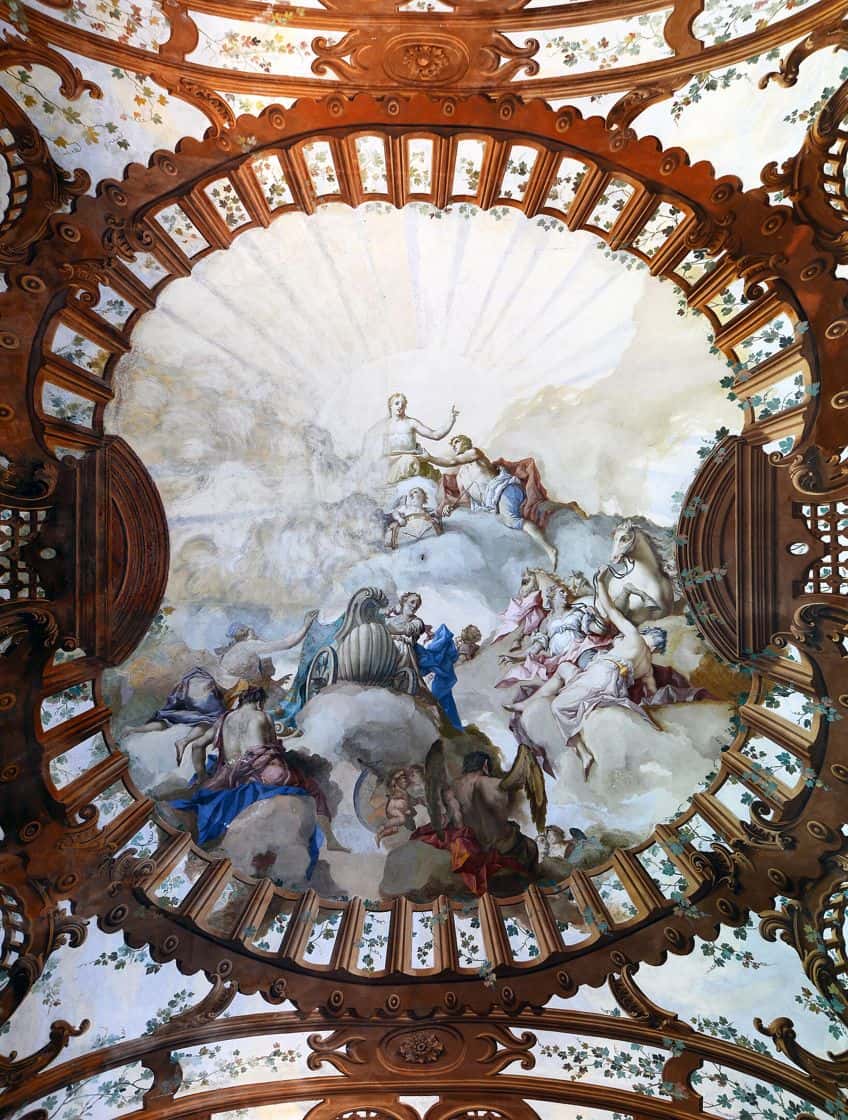
Quadratura requires visual-spatial ability as well as mastery of linear perspective, which Andrea Mantegna pioneered in his ceiling at the Ducal Palace of Mantua. His work had a significant impact on Antonio Allegri da Correggio, often known as Correggio, the head of the Parma High Renaissance. Correggio’s ceiling frescos expanded on the illusionary effects of quadratura by employing new groundbreaking methods such as foreshortening individuals and objects to look real when viewed from below. Melozzo da Forl, an Italian architect and artist, devised this system, commonly known as Melozzo’s perspective.
High Renaissance Architecture
Donato Bramante was the preeminent High Renaissance architect, well known for his focus on classical harmony, the use of a centralized plan, and rotational symmetry, as shown in his Tempietto (1502). The employment of circles, octagons, or squares in rotational symmetry ensured that a structure preserved the same shape from numerous points of view. He also invented the trompe l’oeil technique for architectural reasons at Milan’s Santa Maria presso San Satiro church. Because there was a road behind the church’s wall, just three feet remained for the choir area, therefore the architect employed linear perspective and painting to provide the appearance of greater space.
Sir Barister Fletcher described the Palazzo Farnese, created by Bramante’s disciple Antonio da Sangallo the Younger, as the most magnificent 16th-century Italian palace.
The design followed classical principles, was Spartan in its simplicity, and employed rustication, which left the building stone rough and unpolished, allowing for natural color and lines. Yet, the era was defined by rival designs and personal competition. Cardinal Farnese was unsatisfied with the Palazzo’s cornice design and launched a contest for an improved design, which Michelangelo won. According to legend, Sangallo the Younger passed away of shame the next year, as Michelangelo finalized the structure’s final finishes.
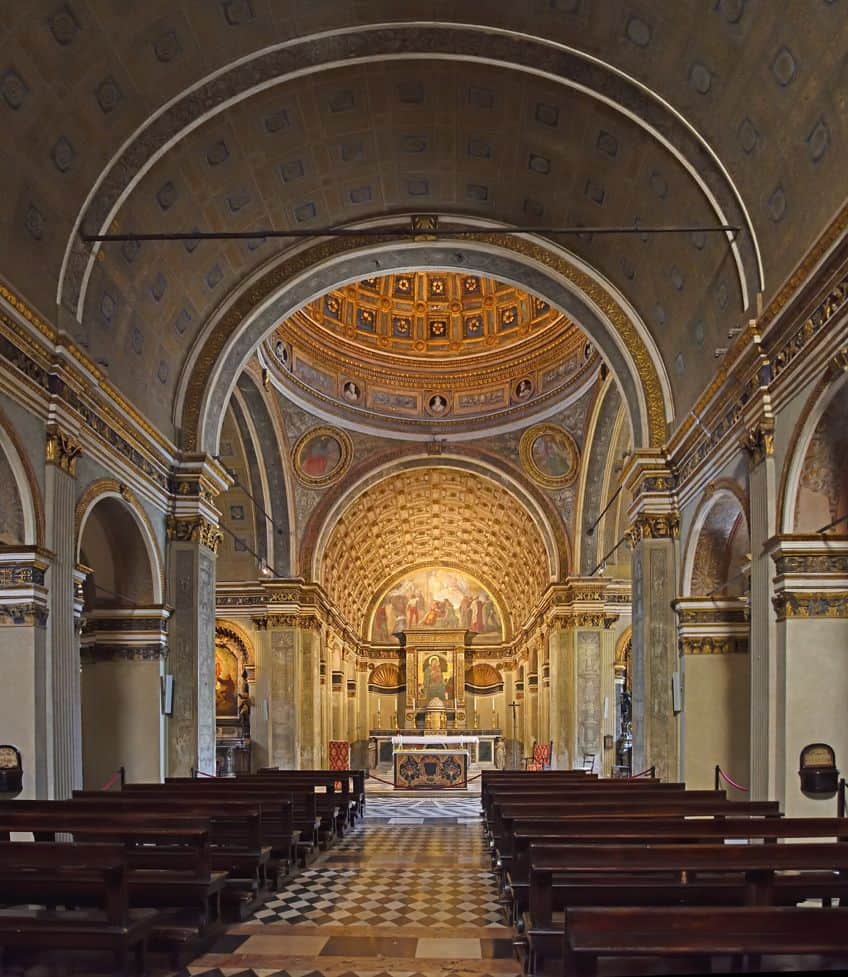
Bramante’s main adversary was Michelangelo, who went on to work as an architect. He produced the dome for St. Peter’s Basilica and was responsible for the design of the Laurentian Library in Florence, however, the structure as a whole represented the designs of Bramante, Raphael, and subsequent architects such as Bernini. This construction, which was completed between 1523 and 1571, was especially inventive, with the staircase and wall elements producing a dynamic feeling of movement that influenced contemporary architects.
High Renaissance Sculpture
Michelangelo was the undisputed master of sculpture throughout the High Renaissance, and his Pietà (1499), completed when he was only 24, started his career. He opted to represent a young Virgin Mary carrying the dead Christ in her lap. Although this scenario was famous in France, it was completely new to High Italian Renaissance art. The pyramidal composition and realistic figurative approach of the painting produced a profoundly classical impact. However, the work also demonstrated creative modifications.
The gigantic stature of the Virgin in relation to Christ gave the picture a profoundly emotional maternal element, and this utilization of strong contrast became a hallmark style for the artist in his work.
Unlike any of the earlier Renaissance artists such as Donatello, who worked in bronze, Michelangelo resurrected the traditional usage of marble and infused facets of monumentality into all of his future sculptures, both in the stature of the people and the scope of the projects. Da Vinci also dabbled in sculpting, creating the world’s biggest bronze horse monument. The Duke of Milan commissioned the project in 1482 to commemorate his father, but it was never completed since the artist’s 24-foot tall clay model was torn down during the French army assault on Milan in 1499. Several contemporary replicas of the horse, based on the artist’s sketches, have been constructed.
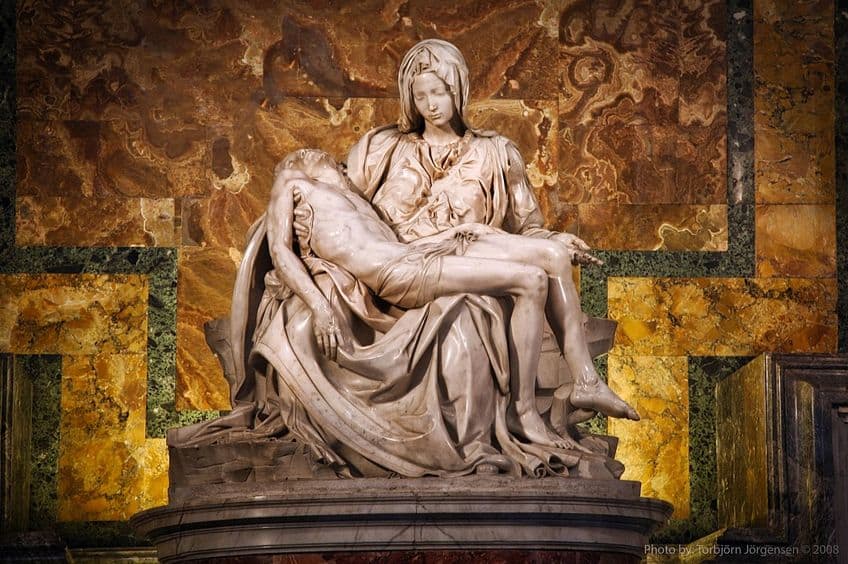
Later Developments and Impact
The High Renaissance principles and humanism proceeded to inspire the globe beyond Italy, albeit with significant stylistic and creative variance. Its impact would extend into the North European Renaissance, as illustrated by Pieter Bruegel, Albrecht Dürer, and others, as well as the Venetian Renaissance, as typified by Titian and Giorgione, as well as the architect Palladio. In the meantime, Correggio’s quadratura works inspired painters Gaurdenzio Ferrari, Carlo Cignani, and Il Pordenone, and had a significant impact on both the Rococo and Baroque dome and ceiling treatments. Da Vinci’s passing in 1519, followed by Raphael’s passing the following year at the age of 37, signified a decline in the vitality of the Italian High Renaissance.
The time period ended in 1527 with the sack of Rome by the army of Holy Roman Emperor Charles V.
The terrible and horrific disaster decreased Rome’s population from 55,000 to 10,000, leaving the city in shambles and financial devastation. Many people no longer believed in the High Renaissance ideals. The Last Judgment (1541), a fresco in the Sistine Chapel by Michelangelo, portrayed the deeper emotional tone of the ensuing decades. In sculpture, he specialized in pietas and portrayals of enslaved people, such as The Atlas Slave (1534).
Later attempts of expression by Michelangelo impacted the Mannerists such as Rosso Fiorentino, Jacopo da Pontormo, Giorgio Vasari, and Francesco Salviati. Numerous painters were influenced by his figurative depiction, notably of the naked male. Subsequent artists of the Baroque era, Neoclassicists, and avant-garde groups of the 20th century were also heavily impacted by Renaissance artworks. For example, in his Guernica (1937), Pablo Picasso drew on Raphael, citing The Fire in the Borgo (1514), which featured a lady offering her baby to others beneath as she leaned out of a burning structure.
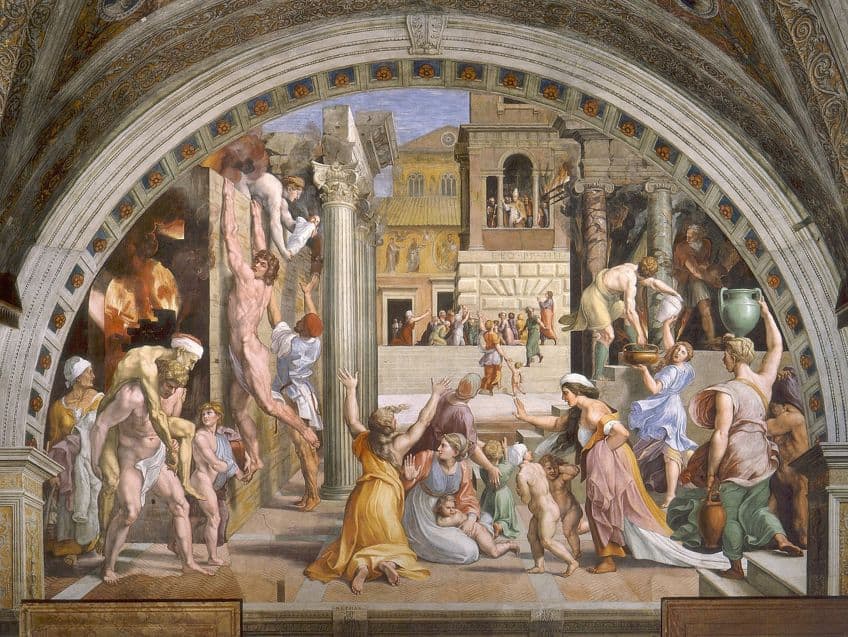
Italian High Renaissance artists created some of the most known and popular works in art history. Many of them have been reproduced on a plethora of commercial items, mentioned in famous songs, TV series, and films, and regularly utilized in advertising. In addition, the High Renaissance principles – the artist as genius, the fundamental character of classical art, the person as the core of the universe, the significance of scientific discovery and exploration, and the importance placed on Humanism – have all strongly affected the globe’s values in society and culture ever since.
High Renaissance Art Characteristics
We have touched on some of the High Renaissance art characteristics in our history section above. These include Humanism, classical influences, and the search for order. Let’s now explore each characteristic in a bit more detail.
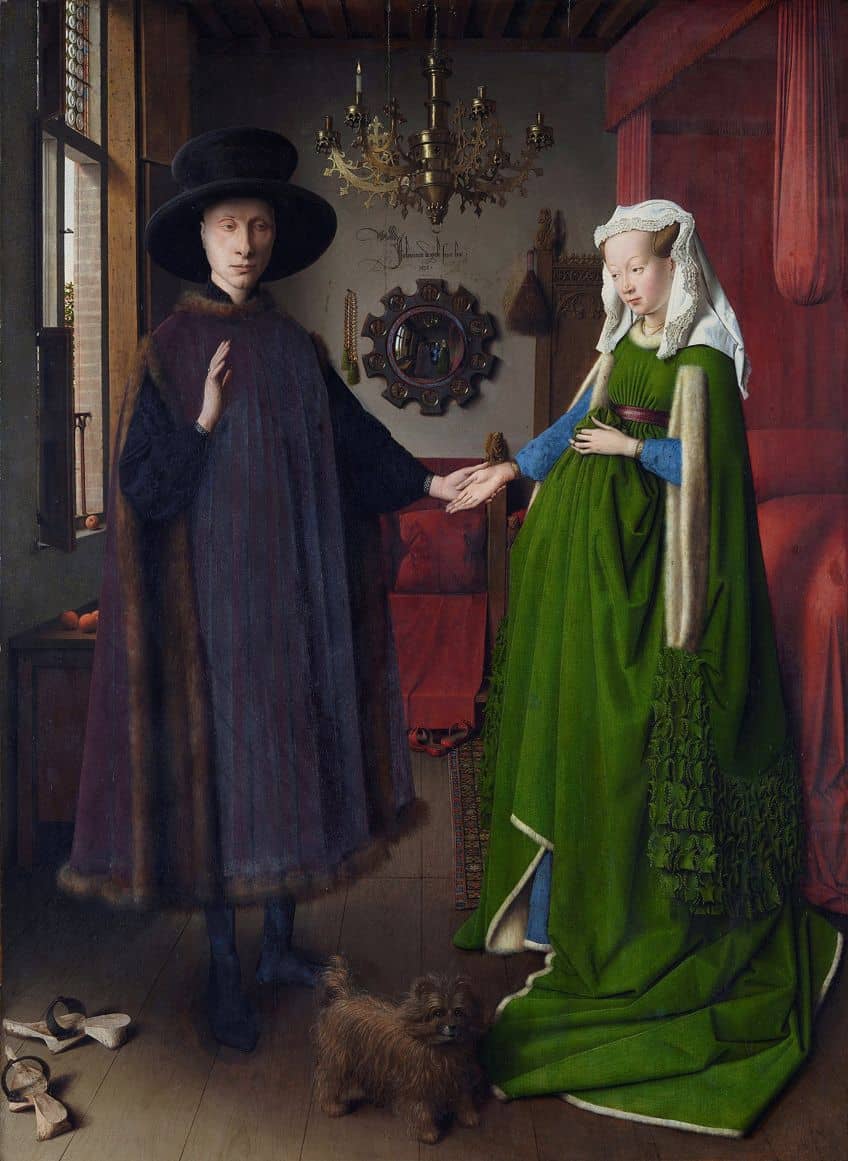
Classical Influences
The culture and artistic endeavors of ancient Greece and Rome were greatly impacted by High Renaissance art, which was valued for its order, beauty, and perfection. High Renaissance artists attempted to imitate the classical forms and methods of ancient art and they often featured classical themes and subjects like history, mythology, and religion.
They also incorporated traditional shapes and proportions in their artworks, including the idealistic human figure, resulting in a feeling of balance and harmony.
Realism
High Renaissance painters were concerned with depicting the natural environment and the human form in a realistic manner. They employed shading, perspective, and foreshortening to produce a feeling of depth and three-dimensionality, and they devoted special attention to subtleties like shadow and light play. This realism was employed to portray drama and emotion.
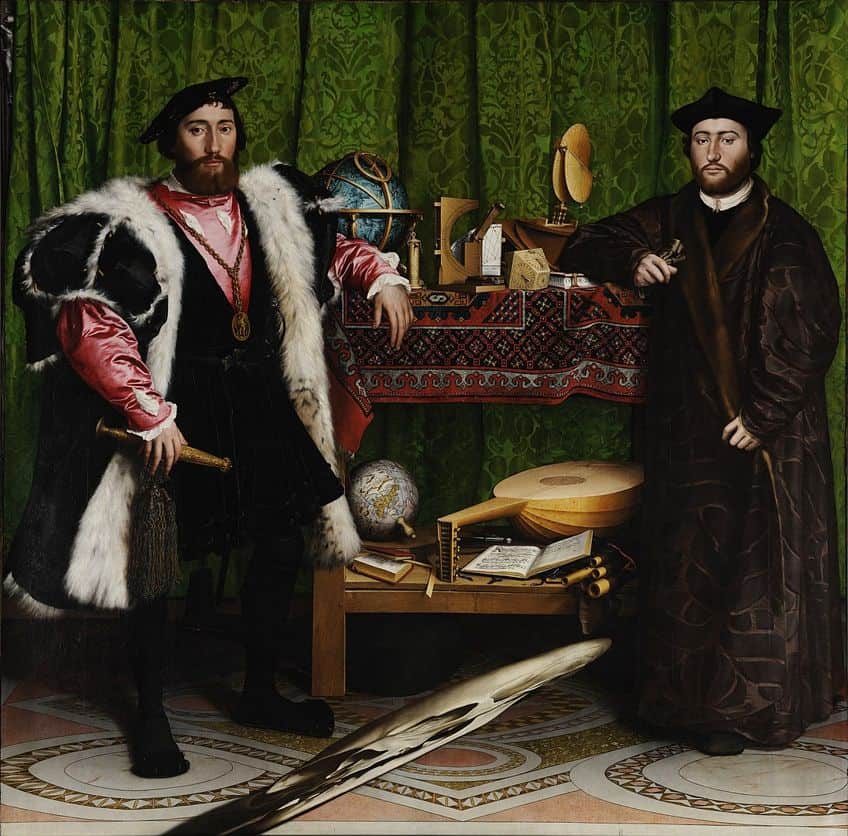 The Ambassadors (1533) by Hans Holbein the Younger; Hans Holbein the Younger, Public domain, via Wikimedia Commons
The Ambassadors (1533) by Hans Holbein the Younger; Hans Holbein the Younger, Public domain, via Wikimedia Commons
Balance and Harmony
The composition of High Renaissance art was characterized by a feeling of order and equilibrium. To create a feeling of visual harmony, artists employed techniques that included proportion, symmetry, and balance, often relying on mathematical concepts such as the golden ratio.
The focus on harmony and balance echoed the ancient ideals of beauty and order.
Technical Skill
High Renaissance artists were competent in the use of a variety of media, including marble, oil paint, and bronze. They were able to produce very intricate and lifelike works of art, demonstrating their technical knowledge and talent. This technical ability was employed to evoke awe and astonishment in the observer, as shown in masterpieces such as Michelangelo’s Sistine Chapel ceiling.
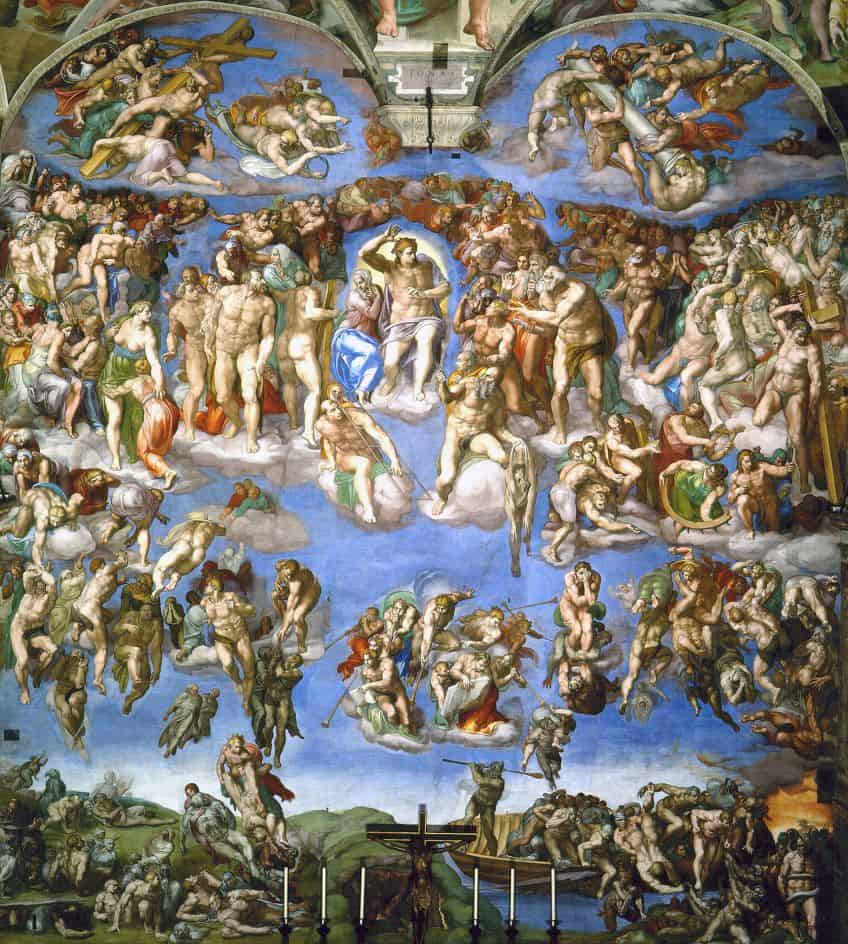 The Last Judgement (1534–1541) by Michelangelo; Michelangelo, Public domain, via Wikimedia Commons
The Last Judgement (1534–1541) by Michelangelo; Michelangelo, Public domain, via Wikimedia Commons
Humanism and Individualism
The humanist ideology of the time, which stressed the significance of human potential, reason, and individualism, had a strong impact on High Renaissance art. Human figures were often illustrated in a way that highlighted their humanity, intellect, and creativity, and numerous works of art conveyed the humanist values of the time. High Renaissance artists were fascinated with the individual as a subject, and they often portrayed individuals in ways that highlighted their distinct attributes and characteristics.
This emphasis on individualism echoed the humanist ideas of the time, which exalted the individual’s ability to achieve greatness.
Examples of High Renaissance Art
The last thing we will explore in this article is a few notable examples of High Renaissance art. These exemplify the High Renaissance time period and were produced by the most noted High Renaissance artists. For example, the first one is by none other than Leonardo da Vinci himself.
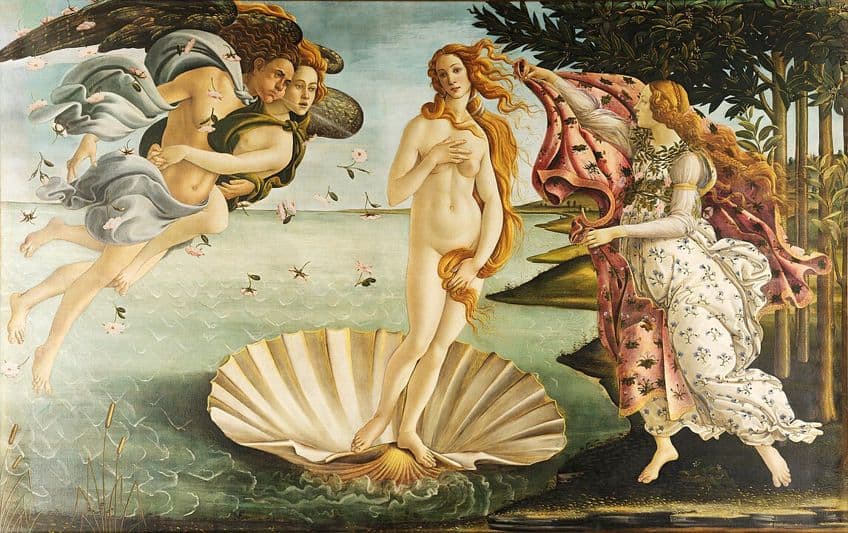
Virgin of the Rocks (1485) by Leonardo da Vinci
| Artist | Leonardo da Vinci (1452 – 1519) |
| Date Completed | 1485 |
| Medium | Oil on panel |
| Dimensions (cm) | 199 x 122 |
| Location | Musée du Louvre, Paris, France |
John the Baptist, The Virgin Mary, and Christ, as well as an angel, are the subjects of this picture. The Virgin is the primary figure at the apex of a pyramidal composition framed by rocks that underline her significance. Looking downward, she extends her arm in benediction to Christ while also inviting the observer into this personal tableau. A pool can be seen in the foreground, with plants like an iris and an aquilegia growing around its margins. A spectacular vision of boulders, and pinnacles rising from the soil, the gloomy depths of tunnels, and an overhead ceiling of stone and fallen trees form the background.
A serpentine river of blue-green water flows through the spaces toward the hazy horizon.
This artwork was unique for a number of reasons. Rather than painting the Virgin as a glorified heavenly queen seated on a throne, he depicted her as a portrayal of Mary that Raphael would also embrace – the humble Madonna. Beauty and grace, instead of traditional iconographic symbology, become the carriers of the scene’s holiness, blurring the lines between the ordinary man and holy characters. The work of art also pioneered the use of sfumato to produce delicate and gentle transitions between facial emotions in order to represent the fluidity of human connection instead of a static, solely two-dimensional image.
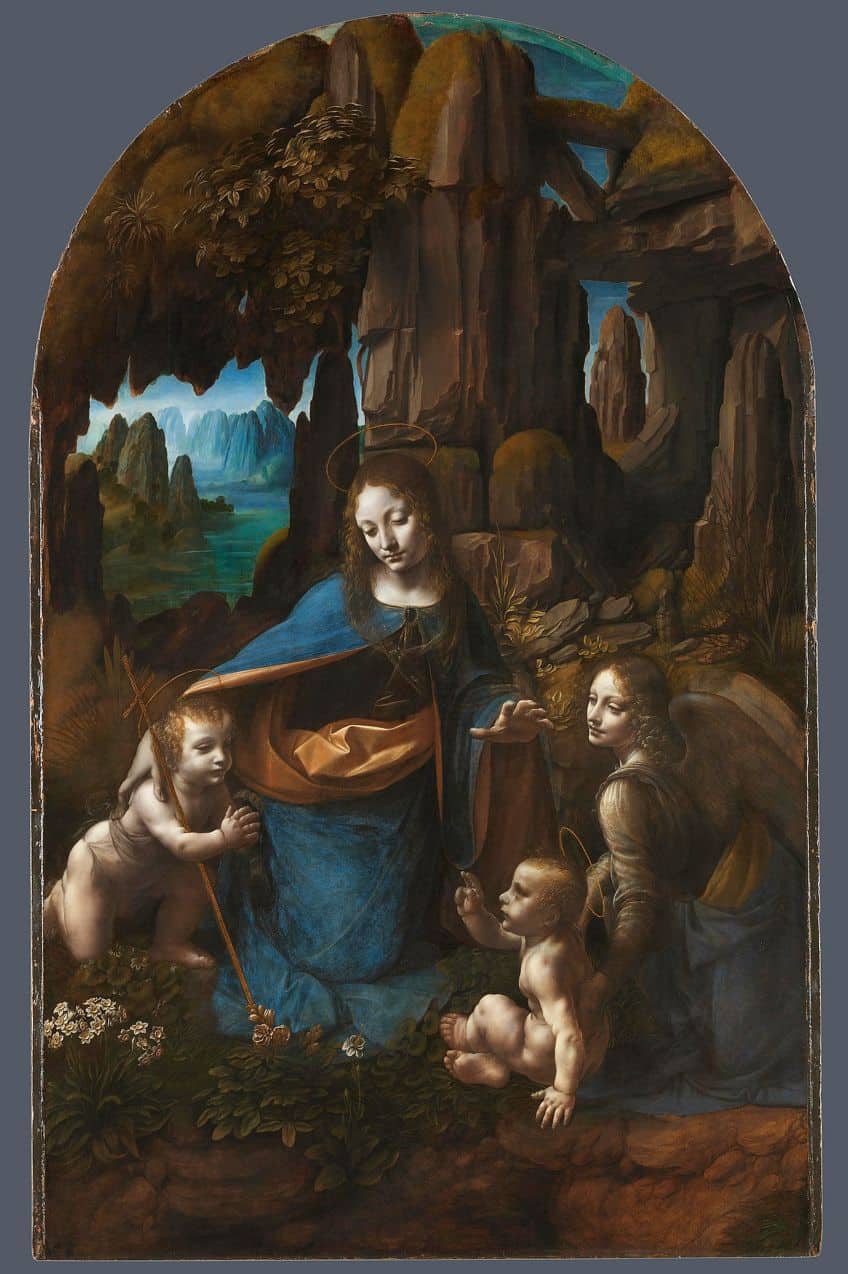
David (1504) by Michelangelo
| Artist | Michelangelo |
| Date Completed | 1504 |
| Medium | Marble |
| Dimensions (cm) | 517 x 199 |
| Location | Gallery of the Academy of Florence, Florence, Italy |
This iconic statue depicts the hero David against the monstrous Goliath. His strong body simultaneously invokes and differs from traditional Greek sculpture, as his long arms and enormous hands show the awkwardness of teenage growth. Michelangelo deviated from earlier depictions by not displaying Goliath or the aftermath of the fight, but rather the moment before, as David turns to evaluate the threat, his wide eyes and prominent forehead suggesting apprehension.
The slingshot slung over David’s shoulder is the single thing that distinguishes him as the Biblical hero.
What is important is that this sculpture was the first time the naked male form had been carved in a piece of marble since the ancient age. While the painting has a classical appearance, there are elements that demonstrate High Renaissance artists’ individual methods. Despite Michelangelo’s mastery of precise anatomical precision in his figures, the proportions diverge in this piece, as the right hand is bigger than the left, and his eyes also display an exo-deviation, staring in two slightly different directions.
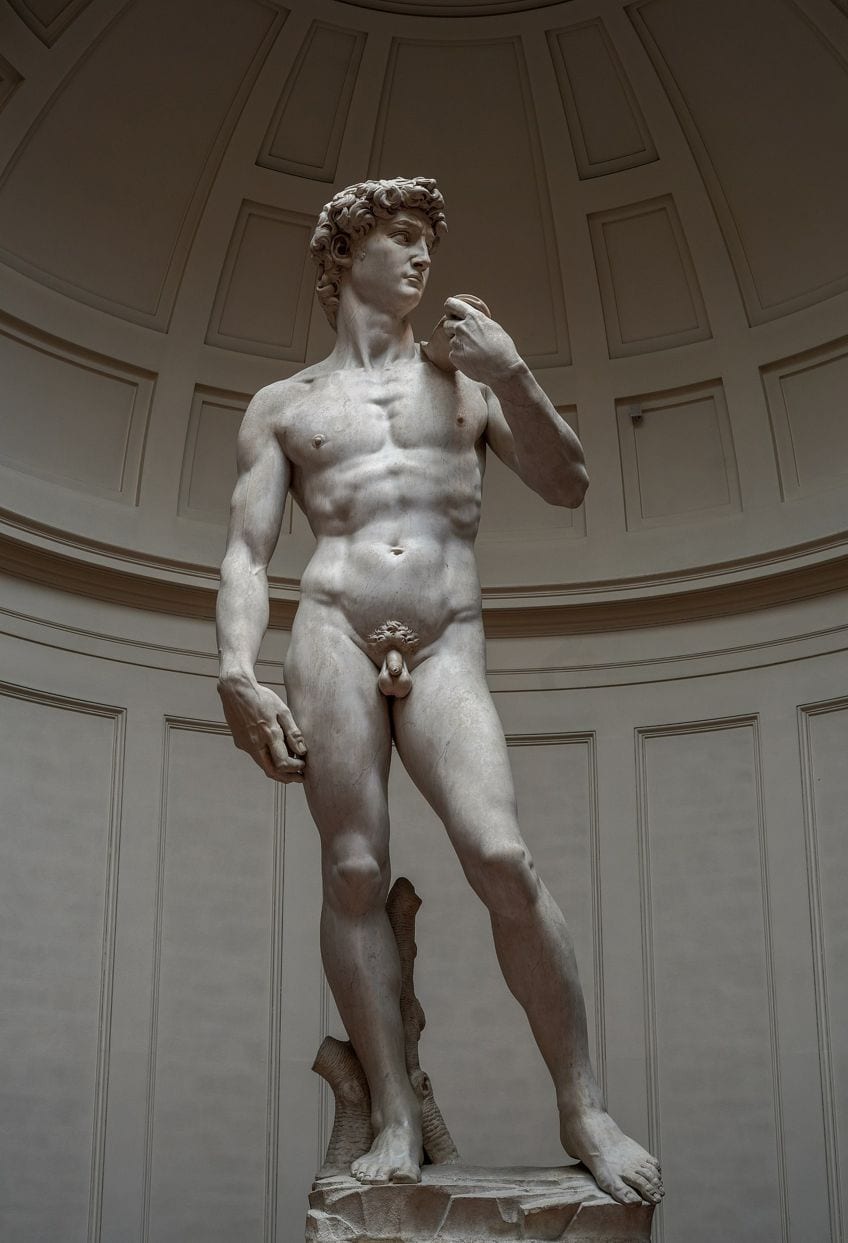
The Alba Madonna (1510) by Raphael
| Artist | Raphael |
| Date Completed | 1510 |
| Medium | Oil on panel transferred to canvas |
| Dimensions (cm) | 94 |
| Location | The National Gallery of Art, Washington D.C., United States |
This picture depicts the Virgin Mary amid an Italian countryside with kid representations of Christ and John the Baptist. The facial emotions and body language are wonderfully human and spiritually evocative, delivered with a fluid and exact authenticity. The Virgin’s glance, as her right arm extends out to comfortingly pat John on the shoulder, foreshadows future events. While his left-hand grabs the base of the wooden crucifix, he returns her glance with understanding.
The infant Jesus reaches out to grasp the cross while looking earnestly at John.
With its green hills, lakes with various buildings, and a mountain range in the background against a peaceful blue sky, the idealized scene provides a sense of tranquility, while a drift of clouds ascending above Jesus’ head is both realistic and alludes to the holy spirit. This was one of Raphael’s main works after relocating to Rome in 1508 to serve Pope Julius II. It is a classic example of his painting of the “Madonna of Humility”, which was frequently utilized by both he and his artistic contemporaries to express a non-idealized picture of Mary as a woman or mother obviously related to daily humans. The use of the circle painting (or tondo), brings viewers even further into the intimate image, evoking a sense of profound closeness.
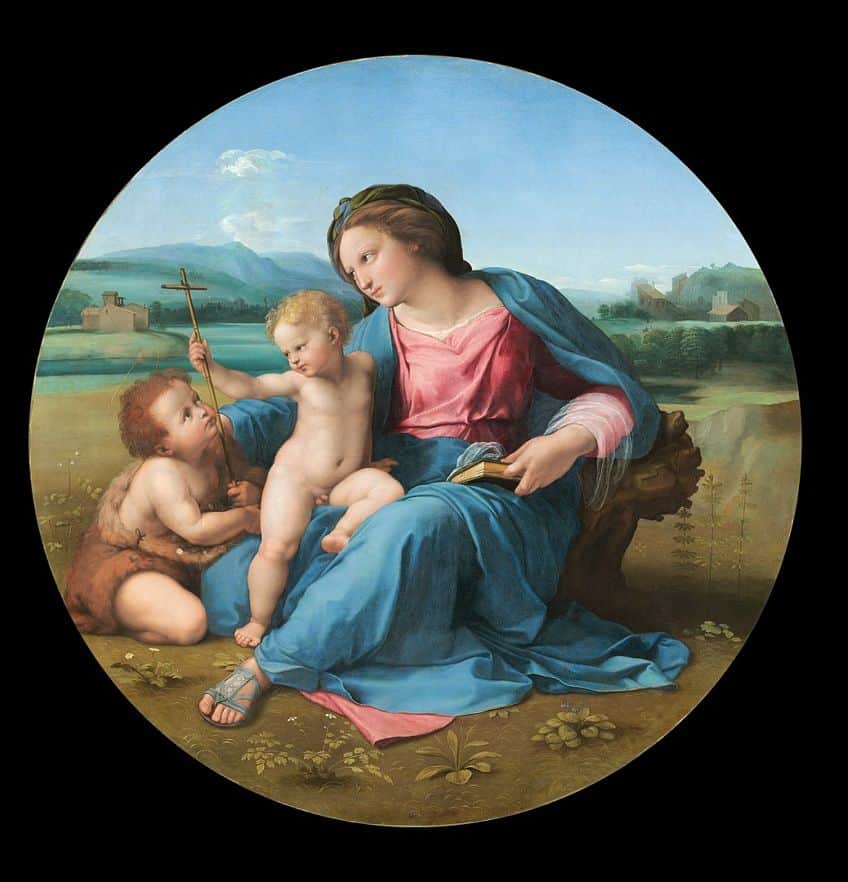
Although many artists competed for status and jobs during the High Renaissance time period, Michelangelo, Leonardo da Vinci, Raphael, and architect Donato Bramante are without a doubt the period’s most famous legends, exemplifying the concept of a “Renaissance Man” in their expertise and proficiency of a variety of interests. Whereas the preceding Early Renaissance was focused on Florence and primarily funded by the Medici family, the High Renaissance time period was focused on Rome and funded by the Popes. In fact, it almost bankrupted the city. The High Renaissance took place against a backdrop of rising political and religious tensions, which had an impact on sculptors and painters as well as collectors of art throughout Italy. After the fall of Rome in 1527, it was supplanted by Mannerism, which was a more artificial and theatrical style.
Take a look at our High Renaissance webstory here!
Frequently Asked Questions
When Was the High Italian Renaissance?
The High Italian Renaissance was a time of creative and cultural flowering in Italy that lasted from the late 15th to the early 16th century. It is widely assumed that it began in the 1490s and continued until the fall of Rome in 1527. This time saw an outpouring of creative innovation and intellectual success, with painters, authors, and intellectuals producing some of the most important works in Western culture and art during this time.
Why Was High Renaissance Art Influential?
Artists of the High Renaissance were able to create incredibly realistic and intricate masterpieces that exhibited their technical knowledge and talent. This technical dexterity was regularly breathtaking, and it redefined what was achievable in the visual arts. Humanist philosophy, which highlighted the significance of autonomy, logic, and human potential, had a strong effect on High Renaissance art.
Jordan Anthony is a Cape Town-based film photographer, curator, and arts writer. She holds a Bachelor of Art in Fine Arts from the University of the Witwatersrand, Johannesburg, where she explored themes like healing, identity, dreams, and intuitive creation in her Contemporary art practice. Jordan has collaborated with various local art institutions, including the KZNSA Gallery in Durban, the Turbine Art Fair, and the Wits Art Museum. Her photography focuses on abstract color manipulations, portraiture, candid shots, and urban landscapes. She’s intrigued by philosophy, memory, and esotericism, drawing inspiration from Surrealism, Fluxus, and ancient civilizations, as well as childhood influences and found objects. Jordan is working for artfilemagazine since 2022 and writes blog posts about art history and photography.
Learn more about Jordan Anthony and about us.
Cite this Article
Jordan, Anthony, “High Renaissance Art – Explore the Return to Classical Ideals.” artfilemagazine – Your Online Art Source. October 24, 2023. URL: https://artfilemagazine.com/high-renaissance-art/
Anthony, J. (2023, 24 October). High Renaissance Art – Explore the Return to Classical Ideals. artfilemagazine – Your Online Art Source. https://artfilemagazine.com/high-renaissance-art/
Anthony, Jordan. “High Renaissance Art – Explore the Return to Classical Ideals.” artfilemagazine – Your Online Art Source, October 24, 2023. https://artfilemagazine.com/high-renaissance-art/.


